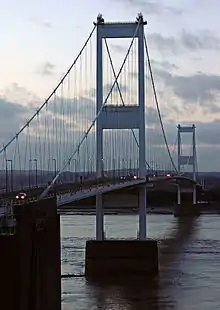Gilbert Roberts
Sir Gilbert Roberts (18 February 1899 – 1 January 1978) was a British civil engineer who designed many famous bridges worldwide.[1]
Sir Gilbert Roberts | |
|---|---|
| Born | Gilbert Roberts 18 February 1899 |
| Died | 1 January 1978 (aged 78) |
| Awards | Royal Medal (1968) Fellow of the Royal Society[1] |
Education
Roberts was born in Hampstead, north London, to Henry William Roberts, a pharmacist, and was educated at Bromley High School.[1] He then went to Gresham College to study engineering but on the outbreak of WWI he joined the Royal Flying Corps.
Career
After being shot in the knee in 1918 on a bombing raid, Roberts was invalided back to England and awarded an Army Scholarship to attend City and Guilds College of Imperial College, where he obtained his degree in 1923. He became a civil engineer and worked on the Sydney Harbour Bridge (1932) and Otto Beit suspension bridge (1938) across the Zambezi River.

As a senior partner with the British firm Freeman Fox & Partners he designed, in collaboration with William Brown, the Volta River Bridge (1957), the Auckland Harbour Bridge (1959–71), the Forth Road Bridge (1964), the Severn Bridge (1966), the Bosphorus Bridge (1973) and the Humber Bridge (1981).
Awards
Roberts was knighted in 1965. He was elected a Fellow of the Royal Society[1] on 18 March 1965.[2] His application citation read: "Distinguished for his contributions to civil engineering by advancing the design of structures, particularly long span bridges. Designer of Severn Bridge, Forth Bridge, Volta Bridge, Maidenhead Bridge, Auckland Harbour Bridge. Also contributed designs of other unusual structures, such as C.S.I.R.O. Radio Telescope, High Marnham Power Station, the Dome of Discovery at the Festival of Britain Exhibition, crane structures including 500 tons goliath crane for Babcock & Wilcox." He was awarded their Royal Medal in 1968.[3]
Personal life
Roberts married Elizabeth Nada Hora in London in 1935. He died in St Stephen's Hospital, London on 1 January 1978.
References
- Kerensky, O. A. (1979). "Gilbert Roberts 18 February 1899 – 1 January 1978". Biographical Memoirs of Fellows of the Royal Society. 25: 477–503. doi:10.1098/rsbm.1979.0017.
- "List of Fellows of the Royal Society 1660 – 2007" (PDF). Royal Society. Retrieved 7 September 2014.
- "Royal Medal". Retrieved 6 December 2008.